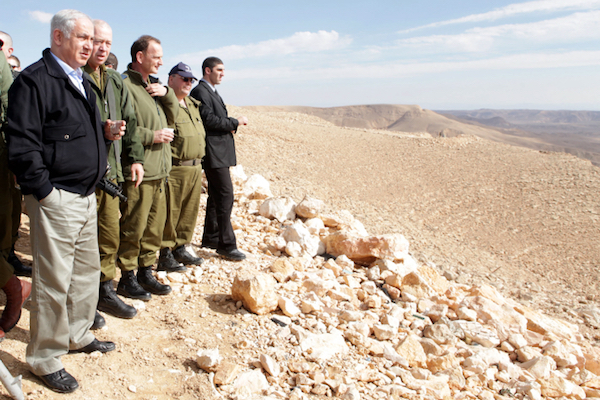According to Israel’s leaders, the Middle East is made up of primitive tribespeople and Islamic radicals who cannot be negotiated with. They’re wrong.
By Idan Barir and Ori Goldberg

Nearly a month ago, a hearing at the Knesset’s State Control Committee that looked into the State Comptroller’s report on Israel’s handling of Operation Protective Edge, brought together Prime Minister Benjamin Netanyahu and Meretz chairwoman Zehava Galon. During the hearing, Galon asked the prime minister what kind of future he proposes for Israeli citizens. His response had quite an impact on his supporters, who shared the video on social media under the headline, “The prime minister silences Zehava Galon.” For nearly three minutes, Netanyahu, in a rare moment of spontaneity, honesty and fervor, fleshed out his political, security-based, and economic worldview. It would behoove us to analyze how Netanyahu views the reality in the region, and perhaps especially the distinction between truth and lies.
“I suggest you get to know the reality,” Netanyahu said to Galon. “You wanted a ‘New Middle East?’ You got it. Radical Islam is everywhere. Any territory you evacuate, you get radical Islam […] more tunnels, more rockets […] have I solved the problem of Hamas? Without fully occupying you cannot solve the problem […] I don’t have the option of cleansing the Middle East around me of this murderous ideology, just as unfortunately I cannot cleanse Syria or Iraq from the murderous ideology of ISIS, and unfortunately we currently have no way to change Iran’s obsessive ideology.”
Between ISIS and the tribespeople
It turns out that according to the prime minister, at the root of the Middle East lies radical Islam. Thus, anywhere we leave radical Islam alone, it comes bubbling to the surface. Let’s put aside the baseless connection between Hamas and ISIS. Let’s focus on what Netanyahu was getting at: there are no real states in the Middle States. One cannot “cleanse” Syria and Iraq, or accede territory to Palestinians, since the sovereign Middle East state is no more than a cover. It does not have the vitality or the grasp that radical Islam has. And since radical Islam is characterized by obsessiveness and irrationality, one cannot negotiate with it. This is very sad, of course, but “we have no choice.” Israel is a state, and since states are rational entities that fully understand the reality, they define everything that stands before it as the exact opposite.
Netanyahu’s comments are one side of the coin. On the other side is our work as researchers of the Middle East. When we write about the complexity of the region and falsehoods such as “the Arabs are the same Arabs,” we often encounter a variation on the following theme: “There are no real states in the Middle East. No nationalities. Only tribes, ethnic minorities, extended families and local-ancient identities. Every attempt to engage with this reality is bound for failure, since one cannot hold stable, valid negotiations with such a wide group. They do what is good for them whenever is good for them, and a state cannot rely on such childish and primitive behavior.”
A clear example for this argument is, of course, “it’s great that we did not sign a peace agreement with Assad’s father that would have seen the return of the Golan Heights.” Even many who understand the complex reality in the region think this way. The belief that states do not really exist in the Middle East is stronger than any other. The threats that engulf Israel on all sides have become entrenched in popular opinion: on the one hand, we face widespread radical Islam. On the other side is always the lone Arab or Muslim whose very essence seeks to undermine all possibility of minimal stability. If only there were states here, rational entities with whom we could reach understandings and live alongside in peace, then, maybe. But there are none. And that’s it.
Losing our grip
The Israeli public is involuntarily blind to the fact that this worldview assumes “the rational” is a synonym for progress, democracy, and humanity. In other words, everything we are and everything our neighborhood isn’t. Thus, if rationality is an expression of humanity, then rejecting it means rejecting humanity. The de-rationalization of the region is its dehumanization. This way, the Jewish-Israeli collective defines itself as supreme over the riffraff of the Middle East, who are either tribespeople or radical Islamists, and in any case they remain in self-important collectives, bereft of any independent humanity or rationality that leaves them with little-to-no simple, pragmatic judgement of their own.
Yet the truth, as it so happens, is more complex. There are states in the Middle East. There are rational leaderships making their way with determination and sensitivity, just like us. Not always successfully, and sometimes due to a different rationale than “ours.” That goes for Iraq, Tunisia, Egypt, the Emirates, Turkey, and even Iran. In Israel we have abandoned our respect for the process and worldview of others, holding fast to their failures as if they were the most important thing. Our truths — which belong to us alone — are total, much like our grief. Our grief. And other truths, sometimes competing ones, are not true at all.
The power of Netanyahu’s Israel, at least in its view, is in its difference, its uniqueness, its isolation, and defensive seclusion. Beyond that, Israel sees itself as the only truth in a closed and evil region based on lies and forgery, denial and blindness. And yet, those who divide the world into “everything” or “nothing” lose their grip on reality.
Idan Barir and Dr. Ori Goldberg are research fellows at The Forum for Regional Thinking. This post was originally published in Hebrew on Local Call.

